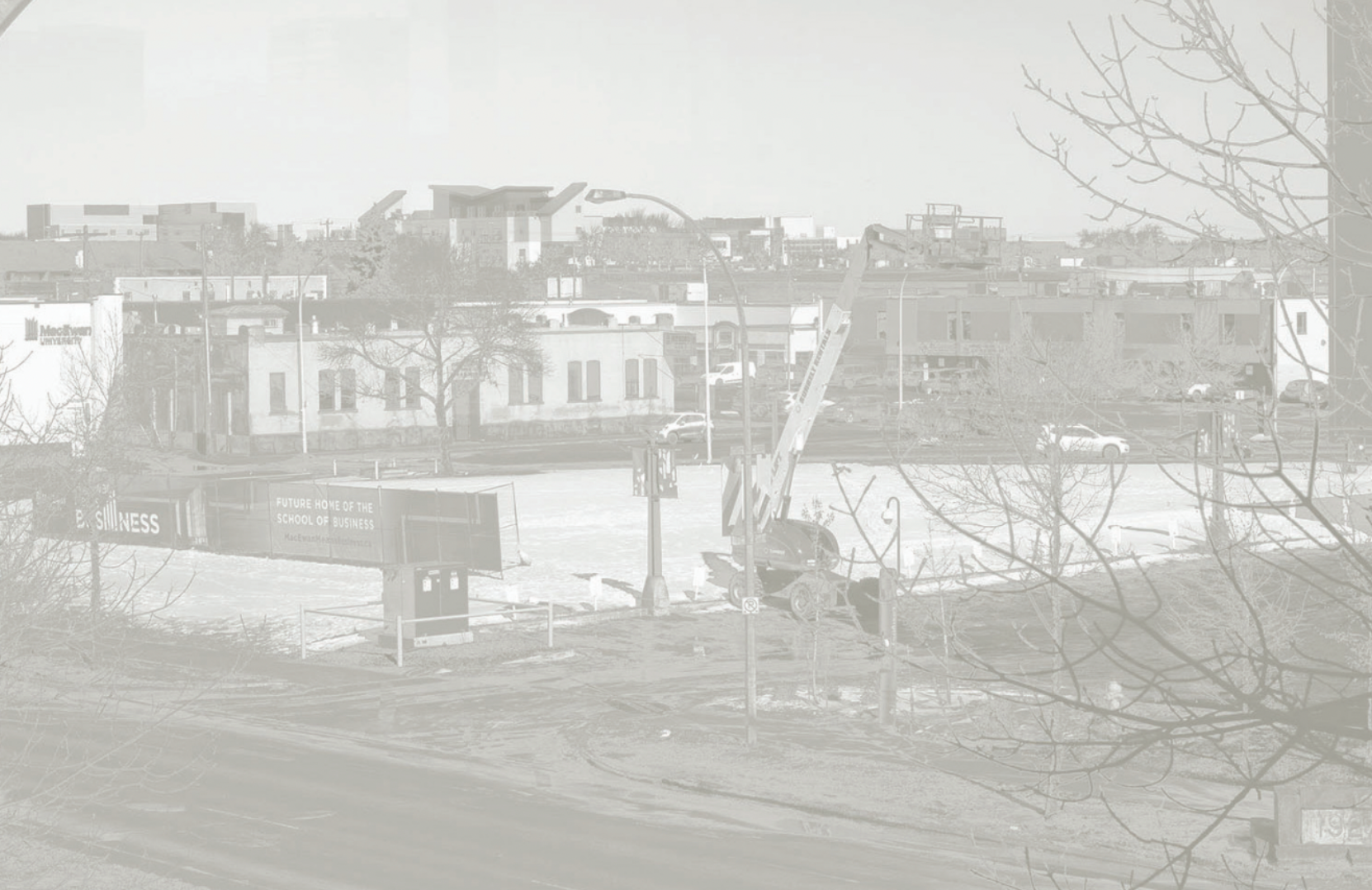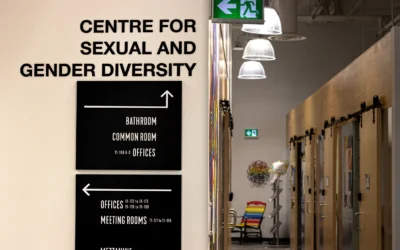MacEwan University is constructing a new building for the school of business. The building will be on the corner of 105 Ave. and 109 St., behind the SAMU building. MacEwan hopes to expand the campus’ capacity and support an additional 7,500 students. The building will feature an open plan on the first floor to engage students, faculty, and any business partners or community members who visit. The rest of all seven planned floors will be constructed in a hierarchy, from student spaces to classrooms to faculty offices at the top. The building is expected to be 376,000 square feet, cost $190 million, and is planned to be completed in 2027.
On Feb. 28, 2023, the Government of Alberta announced that it would invest $125 million into the building and distribute those funds from 2024 to 2028. MacEwan’s fundraising campaign, named “MacEwan Means Business,” plans to raise $25 million to contribute to the project. The president of MacEwan, Annette Trimbee, noted that the university has funds and assets in MacEwan’s coffers that will go towards the project to fill the $40 million gap in funding.
The “MacEwan Means Business” campaign was recently launched and is currently underway. The campaign cabinet includes executives and professionals from various Edmonton companies and is led by co-chairs John Day and Robert Seidel. According to the campaign, MacEwan plans to grow “by five per cent each year for the next 10 years” and to grow to 30,000 total students in the next seven years.
Not only will the building give more opportunities for students and Edmonton businesses, but it will also be home to MacEwan International, the Social Innovation Institute, MacEwan Venture Labs, Careers and Experience, the Office of Research Services, and even more food options for students to choose from.
“It’s a way to bring the public into the broader community within MacEwan,” Myles Dykes, the President of the Students’ Association of MacEwan University (SAMU), says. “They’re trying to direct traffic towards the university (and provide) a place where… partners can meet with students.”
The school of business is currently located in Building 5. “The business building… experiences the lowest amount of faculty offices. You often see (the) faculty of Arts and Science creeping into Building 5. (The school of business is) in need of space ultimately… and they account for about 25 per cent of students here at MacEwan,” Dykes says.
Once completed, Building 5 will likely be given to the faculty of Arts and Science, which only accounts for approximately 15 per cent of the student population.
On Feb. 28, a press conference was held in Robbins Health Centre with a panel consisting of MacEwan President Annette Trimbee; Demetrios Nicolaides, minister of advanced education; Kaycee Madu, minister of skilled trades and professions; Nathan Neudorf, minister of infrastructure; Carolyn Graham, chair on board of governors of MacEwan University; Sine Chadi, cabinet member on the “MacEwan Means Business” campaign; and Myles Dykes, president of SAMU.
Currently, MacEwan has one of the lowest amounts of space available for each student compared to other universities in the province. “Ultimately, there are a lot of space constraints on our campus,” Dykes explains. MacEwan is filled to the brim with students. The city centre campus sees 20,000 students, staff, and faculty daily, which accounts for “a quarter of all foot traffic in downtown Edmonton,” according to Minister Nicolaides.
Dr. Richard Perlow, the MacEwan dean of business, provided insight into the expected technology that will be implemented in the new business department,
which includes a simulated trading floor with augmented reality. Perlow strives to provide real-world experience for students and says he envisions a space that’s beyond “(sitting) at a computer and (pressing) buttons.”
“The trading room contains databases and tools that enable students to evaluate investment opportunities such as investing in a company by purchasing their stock. I envision a class where students prepare reports on companies the students see as an investment option.”
A Board comprised of Edmonton financial experts would review the report and have the students justify their findings in a question-and-answer period that follows an oral presentation to the board. If the Board accepts the students’ recommendation, a trade is made. Proceeds from successful investments will fund student scholarships.”
Graham shed light on the impact the new building will have not just on MacEwan, but on the entire downtown community. She says, “this investment isn’t just about MacEwan. It will also provide much-needed support for local businesses and employers and will help attract industry-leading organizations. It will revitalize our downtown core and strengthen our city and province for the future.”
This building and its prospects are neatly integrated into Edmonton’s downtown vision. The building will face north, allowing the downtown core to merge with the north edge. The university says, “this was a recommendation from our community partners and reflects our commitment to being a connector within Edmonton.”
“We believe that increasing the number of people who study and work in downtown Edmonton is crucial to the revitalization goals of the university, the city, and the province.”
The main concern of students is the cost’s connection to the recent tuition increase. “I’m a little reserved about it just because I’m concerned my tuition will go up to pay for it. Just because of all the different types of funding that have to go into it, I feel like it’s an easy out to just raise tuition,” says Madison, a student in the bachelor of commerce program. Cody Eish, a sessional business instructor, is also worried that “if it grows too fast, maybe the program may feel too watered down … too much growth too fast may be a bad thing.
The recent tuition increase is completely separate from this building, Dykes assures. “They’re hoping for about ($25 million) to be publicly fundraised.”
As of March 21, 2022, MacEwan’s accumulated surplus for the 2021-22 year was $318,559. The annual report states that “the university continues to invest in tangible capital assets,” which includes $18,824 set towards the new business building.
It’s unclear right now how exactly the university will bridge the massive remaining gap if they continue with similar surplus trends hovering around the $300,000 mark in the next couple of years. Trimbee is confident, though, “that this is all going to add up in arithmetic that would get (her) an A plus in (Dr.) Richard’s class,” she joked at the press conference.
Aside from finances, there’s a lot of excitement buzzing around in the business department. Regardless of his concern for rapid growth, Eish is still looking forward to it, “just cause it’ll bring in more students doing (bachelor of commerce) and probably means more course offerings.” There has been a significant increase in engagement in the MacEwan business program in recent years. Rene Morales, a bachelor of commerce major, has noticed his class size shift from around 20 people to nearly 40.
More people means more space needed to support students, and Adrian, in the bachelor of commerce program, is particularly looking forward to more
study space. “Sometimes I wanna go study and can’t find room to sit,” he says. Along with more space, he says, “you can have a better time at school; you maybe want to stay longer instead of going home (since) it’s so busy, and you have no one to talk to.”
“The opportunity to network and … meet people is going to help people strive forward. Having something strictly for us gives us more of an opportunity to grow,” he says.





0 Comments